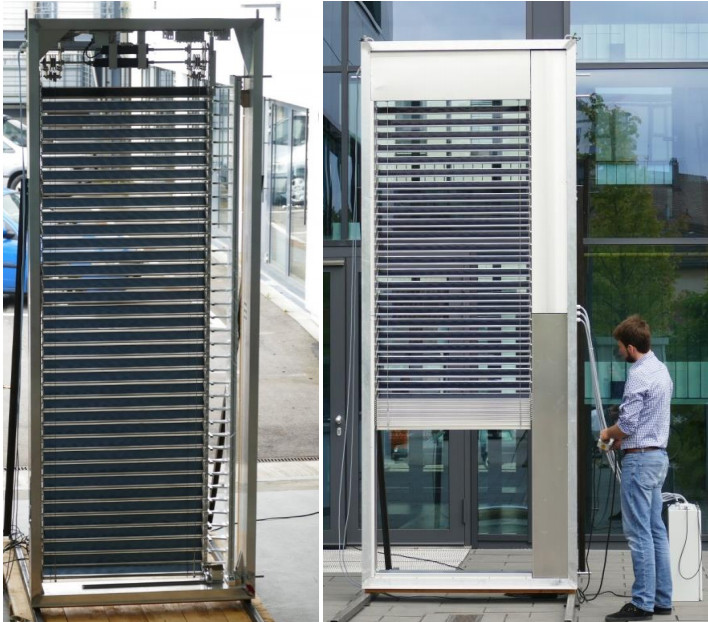Posted: February 24, 2021

Photo: EURAC Research
In the last four years, the multidisciplinary IEA SHC Task 56 research group worked intensively on strategies to increase the market penetration of solar envelope systems. The group has found that prefabrication, a customisable appearance and an interdisciplinary planning process can provide component manufacturers with significant opportunities for growth. Solarthermalworld.org spoke with Paolo Bonato, who works at Italian institute EURAC Research, about the key results of the four-year project and the important lessons learned as included in two recent Task 56 publications, the Technology Position Paper and the Report on the Development of Strategies for Market Penetration.
Are solar envelope systems still a niche market?
Bonato: The level of market penetration depends very much on the type of solar envelope system. There are two main categories. The first relates to solutions controlling solar radiation. Innovative technologies, such as motorised shading and electrochromic glass, have yet to become widespread, whereas traditional shading devices, such as shutters, blinds and curtains, are well-established in the residential and service sectors.
The second category covers building-integrated solar harvesting. Although the number of PV products in this category has significantly increased in past years, adding solar thermal components to facades is still rare.
What are the reasons for the slow uptake of integrated SHC solutions?
Bonato: Building owners tend to be concerned about the possible risks of innovative technologies. Integrated solar heating systems are designed to be multi-functional – they often include weather protection, thermal insulation and solar energy harvesting. The energy they collect is transferred to other subsystems in the building via hydronic or air handling networks.
Therefore, solar systems implicitly require cooperation between many stakeholders in building design, manufacture and construction. Over the years, however, the construction industry has seen its process chains become heavily hierarchised, categorised and standardised, making it difficult for professionals to collaborate around innovative solutions. There are many reasons for this, but two are considered especially critical: First, the disappearance of specialist contractors, and second, the need to control expenses in public procurement.
What actions are needed to make the most of solar envelopes when integrating them into building design practices?
Bonato: We emphasised three main actions in our Technology Position Paper. First, prefabrication offers component manufacturers a huge opportunity for achieving growth and putting higher value-added solutions on the market. A promising facade element prototype that combines conventional Venetian blinds with a solar thermal collector has been developed during German research project Arkol. Second, a collaboration between planners and installers that specialise in different fields offers unique selling points to companies adopting a systemic approach to building design and construction site management. Third, a customisable architectural appearance helps to satisfy differing aesthetic requirements. As there are no general rules about what architects, public authorities, building owners or occupants prefer, manufacturers should provide flexibility in product aesthetics. This would make it easier for architects to design buildings and for building owners to approve those designs. A good example are heating systems by Canadian manufacturer Solarwall, as the devices come in different colours and sizes.

Active blinds powered by solar: This prototype has been one of the highlights of the International Energy Agency’s Today in the Lab – Tomorrow in Energy programme.
Source: Fraunhofer ISE
The Renovation Wave in Europe targets the building stock. Which policies would you recommend the EU Commission adopt to speed up the use of roofs and facades to improve the energy efficiency of buildings in member states?
Bonato: There are indeed several market entry barriers that could be removed by policymakers. The most important one is the current regulatory framework. Building-integrated products are subject to a higher number of country-specific legal approvals, since they need to comply with both construction products regulations and industrial standards on compliance and performance.
As this creates a significant barrier for manufacturers, policymakers should address the obstacle by defining and enforcing a regulatory framework that is as uniform and international as possible and that facilitates compliance with both construction and industrial regulations.
Public authorities should also support the development of evaluation methods to allow stakeholders to estimate solar envelope advantages in the early stages of a project. For example, building owners and planners would greatly benefit from extended solar cadastres. Internet service providers, many municipalities and NGOs provide online solar maps, which could be used to identify areas promising great potential for solar envelope use (e.g. www.kk.dk/solceller).
More information:
https://task56.iea-shc.org/